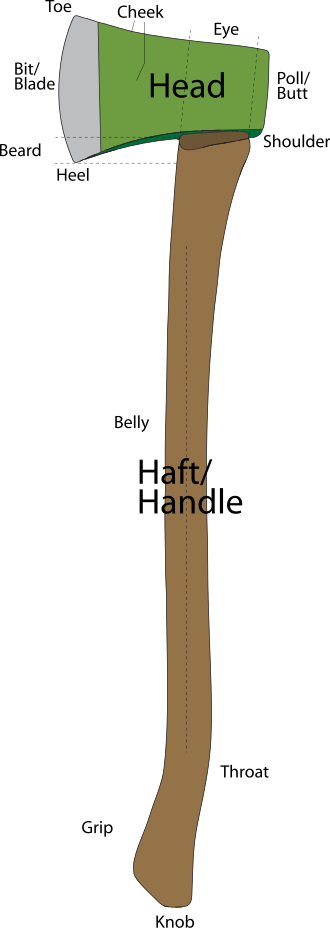Difference between revisions of "AY Honors/Scrapbooking - Advanced/Requirements"
Jomegat bot (talk | contribs) (Bot: Automated import of articles *** existing text overwritten ***) |
Jomegat bot (talk | contribs) m (Add RequirementsHeader) |
||
| Line 1: | Line 1: | ||
| − | + | ==6. Show axmanship knowledge in the following: == | |
| − | + | [[Image:An axe labelled-2edit.svg|thumb|Parts of an axe]] | |
| − | + | ===a. Describe the best types of axes. === | |
| − | + | The "best" type of axe depends on what you're trying to do with it. | |
| − | + | *'''Felling axe''' — Cuts across the grain of wood, as in the felling of trees. In single or double bit (the bit is the cutting edge of the head) forms and many different weights, shapes, handle types and cutting geometries to match the characteristics of the material being cut. | |
| − | + | *'''Splitting Axe''' — Used to split with the grain of the wood. Splitting axe bits are more wedge shaped. This shape causes the axe to rend the fibres of the wood apart, without having to cut through them, especially if the blow is delivered with a twisting action at impact. | |
| − | + | *'''Broad axe''' — Used with the grain of the wood in precision splitting. Broad axe bits are chisel-shaped (one flat and one bevelled edge) facilitating more controlled work. | |
| − | + | ===b. Show how to sharpen an ax properly. === | |
| − | + | It is best to sharpen an axe by hand rather than using an electric grinder. A grinder will heat the blade and ruin the axe's temper. This will cause the bit to soften making it impossible for the axe to hold a sharp edge during typical use. If the axe is very dull or has visible notches in the blade, start sharpening with a file. The file should be held at an angle and run over the length of the blade. Sharpen both sides until the notches are gone. If the axes just needs a touch-up, you can use a sharpening stone. Wet the stone with water (or if you have an oilstone, with oil). This will cause the filings to "float" away an prevent them from clogging the pores in the stone (making it smoother and thus, less effective at sharpening). | |
| − | |||
| − | |||
| − | |||
| − | |||
| − | |||
| − | |||
| − | |||
| − | |||
| − | |||
| − | |||
| − | |||
| − | |||
| − | |||
| − | |||
| − | |||
| − | |||
| − | |||
| − | |||
Revision as of 01:32, 24 November 2020
6. Show axmanship knowledge in the following:
a. Describe the best types of axes.
The "best" type of axe depends on what you're trying to do with it.
- Felling axe — Cuts across the grain of wood, as in the felling of trees. In single or double bit (the bit is the cutting edge of the head) forms and many different weights, shapes, handle types and cutting geometries to match the characteristics of the material being cut.
- Splitting Axe — Used to split with the grain of the wood. Splitting axe bits are more wedge shaped. This shape causes the axe to rend the fibres of the wood apart, without having to cut through them, especially if the blow is delivered with a twisting action at impact.
- Broad axe — Used with the grain of the wood in precision splitting. Broad axe bits are chisel-shaped (one flat and one bevelled edge) facilitating more controlled work.
b. Show how to sharpen an ax properly.
It is best to sharpen an axe by hand rather than using an electric grinder. A grinder will heat the blade and ruin the axe's temper. This will cause the bit to soften making it impossible for the axe to hold a sharp edge during typical use. If the axe is very dull or has visible notches in the blade, start sharpening with a file. The file should be held at an angle and run over the length of the blade. Sharpen both sides until the notches are gone. If the axes just needs a touch-up, you can use a sharpening stone. Wet the stone with water (or if you have an oilstone, with oil). This will cause the filings to "float" away an prevent them from clogging the pores in the stone (making it smoother and thus, less effective at sharpening).

